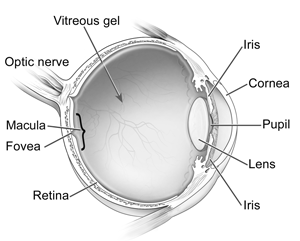Corneal Ulcers
What Are Corneal Ulcers?
The cornea is the clear, round dome that covers the iris, the colored portion of your eye, and the pupil, the black circle in the center of the iris. Like the clear face of a watch protects its inner parts, the cornea also provides a protective layer around the eye. It also helps focus light through the eye’s lens onto the retina, and plays an important role in our vision.
Photo Credit: National Eye Institute, National Institutes of Health
Our corneas are comprised of five layers: Epithelium, Bowman's membrane, stroma, Descemet's membrane and the endothelium. Corneal ulcers always begin with some defect in the epithelium, such as a corneal abrasion. Most commonly, they are associated with an injury to the cornea, which then becomes infected by a bacteria, fungus, virus or Acanthamoeba, a type of microbe found in dirty water. This type of corneal ulcer is called infectious.
The initial injury to the cornea can be caused by many things including a foreign body in your eye, irritation caused by improper use of contact lenses, extreme dry eye, an ingrown eyelash or an eyelid that turns inward (entropion). Because a corneal ulcer has the potential to seriously damage your vision, it should be considered an ocular emergency. You should call your doctor immediately if you experience the following symptoms:
- Painful eye
- Feeling like something is in your eye
- Redness
- Teary eye
- Sensitivity to light
- Small white dot on your eye
White pus may appear on the cornea as well as behind it, although this may not be visible to the naked eye. An untreated ulcer may penetrate deeply into the cornea, resulting in greater pain and increasing the risk of complications.
Wearing contact lenses is safe as long as you rigorously adhere to the prescribed cleaning, handling and disinfecting process. However, contact lens wearers who do not follow these procedures are at particular risk for developing corneal ulcers from bacterial infections. This is especially true if you wear soft contact lenses. The high water content in the lenses make it easier for bacteria to thrive, if you do not strictly adhere to your cleaning regiment. Certain types of bacteria, including pseudomonas, are extremely aggressive and can lead to blindness within as little as two days in people with corneal ulcers. While everyone who has the symptoms of a corneal ulcer should contact their doctor immediately, this is especially true if you wear contact lenses. Contact lens wearers should avoid using tap water on their contacts and never wear them in hot tubs or saunas.
The second type of corneal ulcer is called a sterile ulcer. A sterile ulcer is usually not painful and may be located on the edges of the cornea. A sterile ulcer may be an accumulation of cells and fluid that has not penetrated the epithelium. This type of corneal ulcer can be associated with dry eye syndrome.
How Is a Corneal Ulcer Detected?
Your doctor will use a slit lamp examination to detect a corneal ulcer. He / she will first apply fluorescein drops to your eye which will highlight the ulcer. Once the ulcer is confirmed, your doctor will want to determine whether the ulcer is infectious and if it is, what type of infection it is. Normally, infectious ulcers send out star-like branches that can be easily seen on the slit lamp. A diagnosis of infectious versus sterile ulcer will form the basis for your treatment.
To determine the type of infection, your doctor will apply numbing drops to your eye. Then, he / she will gently remove a small number of cells from the surface of your eye. These cells will be tested to determine the nature of the infection.
How Is a Corneal Ulcer Treated?
If your doctor determines the ulcer is an infectious ulcer, the treatment will depend upon the nature of the infection. Anti-bacterial, anti-viral or anti-fungal medications will be used as appropriate. The initial treatment is usually in a form of eye drops. However, if the infection is advanced, oral or intravenous medications may be prescribed. As healing of the ulcer progresses, your doctor may also add a steroid eye drop to your treatment. This reduces inflammation and may help minimize scar formation.
Sterile ulcers will normally be treated with a steroid eye drop. This will reduce inflammation and promote healing.
With a corneal ulcer, you will not require an eye patch. While treatment may heal the corneal ulcer, you may be left with a cloudy scar that can impair vision. There may be other complications including a perforated cornea or a deep infection that could result in loss of vision or of the eye itself. If scarring occurs, you may require a corneal transplantation.
Prompt treatment of corneal ulcers is the key to protecting your vision. You should not delay in contacting your doctor if you have injured your eye or if you experience any of the symptoms of a corneal ulcer.

